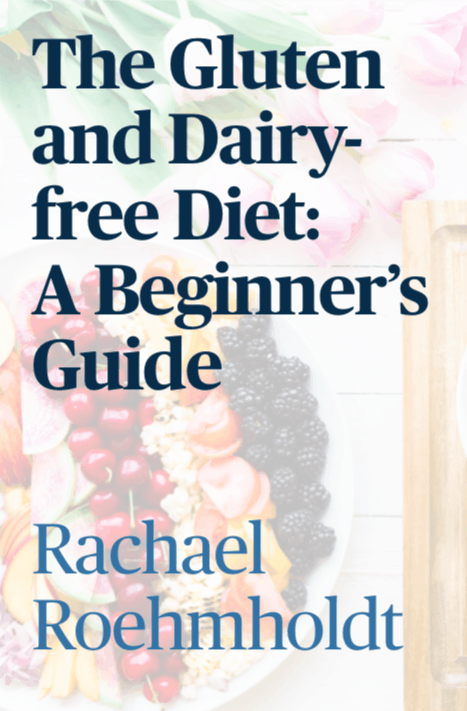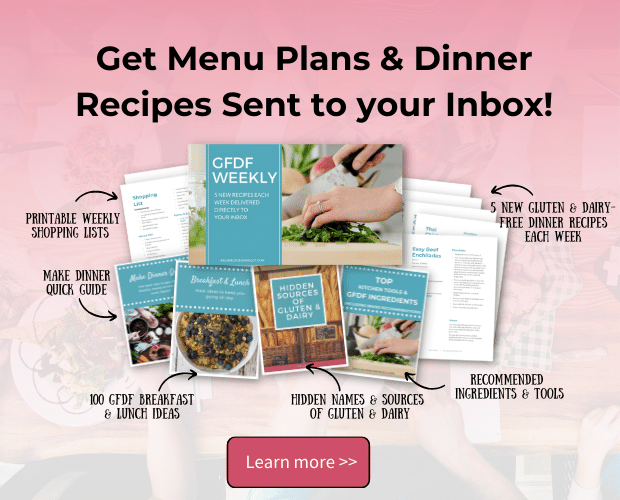Get started with a gluten and dairy-free diet and find out what foods you can enjoy with this food list and PDF printable.
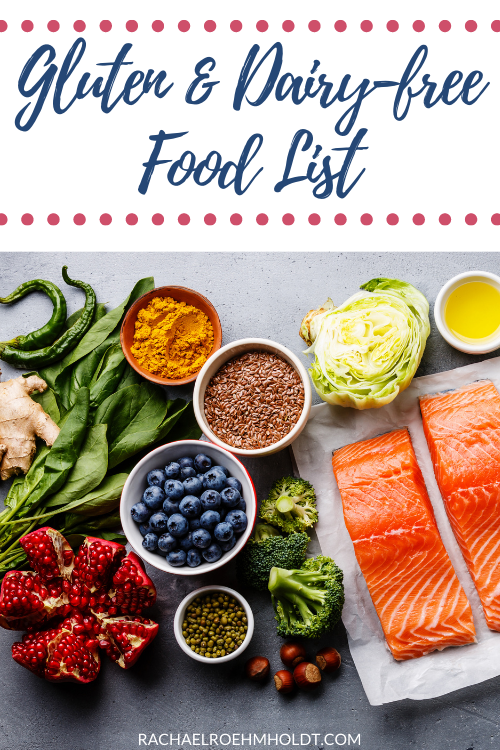
Note: I am a proud Amazon, Chomps, MunkPack, and Thrive Market affiliate and am happy to recommend their service and products to you. Please know that as an affiliate, I may receive a small commission on the products you purchase after clicking through my links. For more info, please see my disclosure policy here.
If you’re just getting started with a gluten and dairy-free diet, you may be at the very beginning stages of learning how to make this diet work for you and your lifestyle.
For many of us who have had to give up foods with gluten and dairy, it can be extremely overwhelming to know which foods are “safe” and which ones to avoid.
Knowing some foods are off limits, like bread, cheese, and ice cream can be pretty straightforward, but it’s pretty discouraging to only think about the foods that we CAN’T continue eating.
That’s why I decided to put together a list of foods that are good options for a gluten and dairy-free diet. This will work for you if you have food allergies, food intolerances, or even celiac disease.
These are a combination of naturally gluten-free and dairy-free foods, as well as some foods you might want to find substitutions for in your regular diet. Foods like vegan butter, gluten-free crackers, and dairy-free cheese.
I think it’s important to take note of the simple ingredients that are always going to be good options and start making meals around them rather than trying to always find one-to-one replacements for foods that you used to eat.
When you know what ingredients you can eat on a gluten and dairy-free diet, making meals and keeping your kitchen stocked with safe options is much easier.
With this list, you should be able to have a stocked kitchen that will make creating tasty recipes for yourself and your entire family even easier.
I’ve divided this list into eleven categories, including:
- Vegetables
- Fruits
- Whole grains
- Nuts & seeds
- Beans
- Meat, fish & eggs
- Canned & packaged products
- Condiments
- Herbs & spices
- Dairy alternatives
- Oils & vinegars
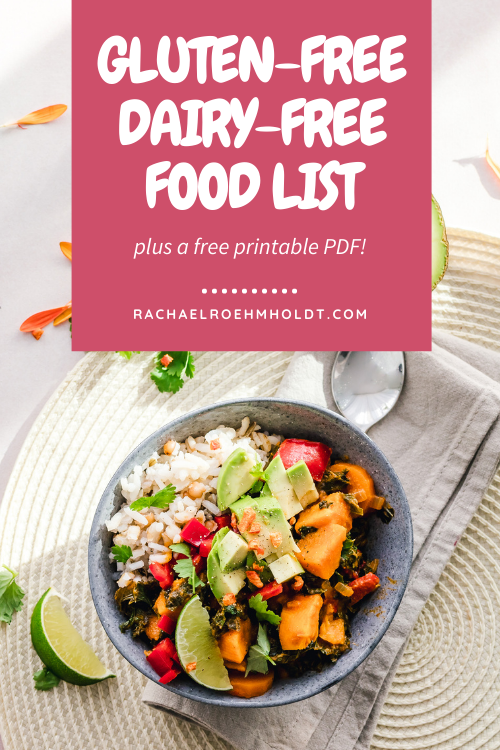
Even though I’ve included these categories, know that there are many more categories and ingredients that you can eat.
This list is to give you a jumping off point for helping you stock up your fridge and pantry and provide some inspiration for meals you can enjoy on a gluten and dairy-free diet.
I like to keep it simple when I’m helping people make the transition, so these are just the basic ingredients you might consider having on hand and start making meals out of. You should be able to find most of these ingredients at your grocery store or online at places like Amazon or Thrive Market.
Over time, as you get comfortable with this diet, you’ll be able to branch out a bit and start getting comfortable with adding more foods and ingredients in.
I cover so much information on my blog about how to go gluten and dairy-free, including dedicated posts with many of these ingredients.
I’ve linked off to some of these posts in the list below if you’re looking for more information or specific brands of some of the packaged foods.
I’ve also literally written the book on getting started as a beginner on a gluten and dairy-free diet.
If you’d like to learn more about taking on a gluten and dairy-free diet, I highly recommend checking out The Gluten and Dairy-free Diet: A Beginner’s Guide. You can find more information on that here or below.
Now let’s go over the gluten and dairy-free food list!
If you’d like this in PDF form, be sure to enter your details to get a free printable copy – plus 5 sample recipes on how to use these ingredients to make meals.
Get the FREE Gluten-free Dairy-free Shopping List
Get access to the most comprehensive - and healthy! - gluten-free dairy-free shopping list around!
Plus get 5 sample gluten-free dairy-free recipes!
Vegetables
For the most part, you can assume that all vegetables are gluten and dairy-free. That is, if they are prepared without other gluten or dairy ingredients in a recipe.
Your best option is to buy fresh or frozen without added ingredients and as close to their natural state as possible to prevent cross contamination.
Enjoy vegetables in salads, soups, stews, smoothies, breakfast hash, as stuffed squash, peppers, or potatoes, in stir-fries, mixed into some desserts for just a few ideas.
- Kale
- Collard greens
- Spinach
- Chard
- Cabbage
- Broccoli
- Red or green leaf lettuce
- Cauliflower
- Green beans
- Asparagus
- Eggplant
- Sweet potatoes or yams
- Potatoes (all varieties)
- Carrots
- Beets
- Acorn Squash
- Butternut Squash
- Zucchini
- Delicata Squash
- Spaghetti Squash
- Tomatoes
- Eggplant
- Kabocha Squash
- Pumpkin
- Onions
- Garlic
- Shallots
- Leeks
- Mushrooms
- Peppers
- Avocado
Fruits
Fruit is also naturally gluten and dairy-free, which is great news, because we need plenty of them to keep us healthy and get fiber, vitamins, and minerals into our diet.
You can enjoy fruit on its own as a snack, in smoothies, oatmeal or smoothie bowls, in salads, baked desserts, and freeze a fruit puree into popsicles or blend into a homemade sorbet in the summer.
- Apples
- Cherries
- Grapes
- Bananas
- Mangos
- Apricots
- Plums
- Peaches
- Nectarines
- Strawberries
- Blueberries
- Raspberries
- Oranges
- Grapefruit
- Lemons
- Limes
- Tomatoes
- Watermelon
- Honeydew
- Cantaloupe
- Kiwifruit
- Pears
- Pineapple
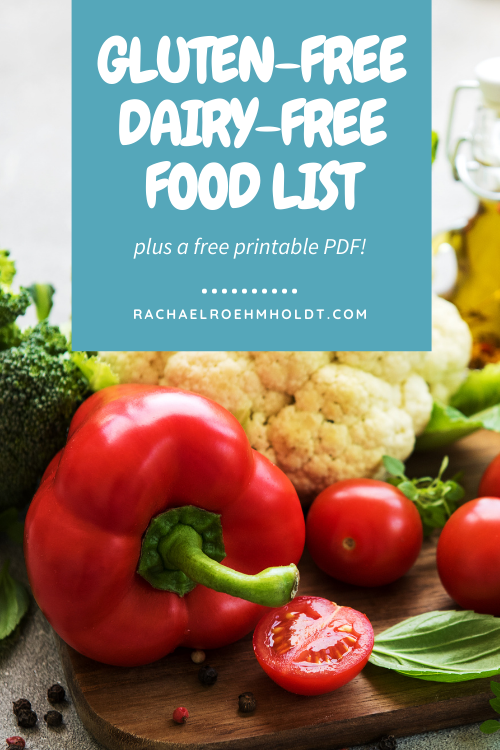
Whole grains
There are plenty of gluten-free whole grain options that you can enjoy on this diet. Whole grains are important for you to include in your diet, because they’re full of vitamins, minerals, protein, and they’re high in fiber.
When you know which whole grains you can eat, you can build meals around them. Grains provide an excellent springboard for ideas, which is why I love incorporating them in my meals.
Various types of rice can turn into side dishes, pilafs or fried rice, rice pudding, rice bowls with different ingredients for breakfast, lunch, and dinner. And that’s just one example!
The main thing to keep in mind when choosing whole grains is to opt for packages that have gluten-free labels. This will tell you that they’ve been processed and tested where there is less than 20ppm of gluten.
Otherwise, you can assume there is a risk of cross contamination during manufacturing – including buying whole grains from bulk bins.
- White rice
- Brown rice
- Jasmine rice
- Wild rice
- Arborio rice
- Quinoa
- Kasha (buckwheat)
- Quick-cooking, steel cut, or rolled old fashioned oats (choose “gluten-free” oats)
- Amaranth
- Teff
- Millet
- Popcorn
- Sorghum
A lot of my pantry staples, including whole grains, nuts and seeds, and canned products come from Thrive Market these days.
What I love about them is that you can filter for gluten-free and/or dairy-free products, making it easy to choose and order exactly what you need to stay on track with your food needs.
If you aren’t familiar with Thrive Market, they have amazing gluten and dairy-free foods, as well as supplements and probiotics.
You can check out all the great things I have to say about this service, AND get a 30% off your first order AND a free gift (up to $24 value) when you sign up for either their monthly or annual plan.
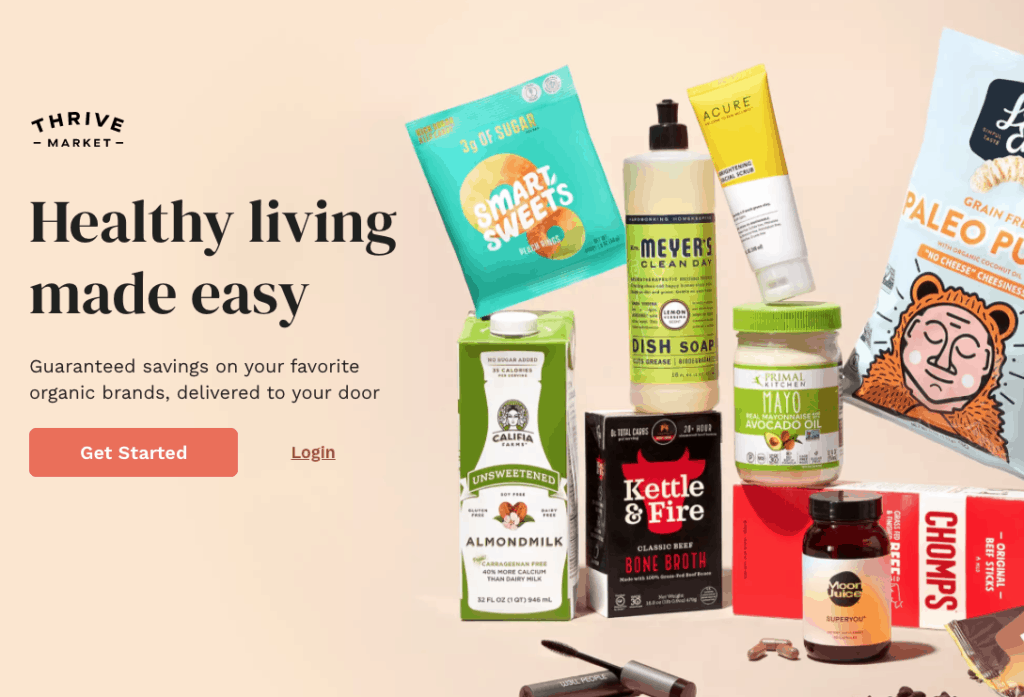
Nuts & seeds
Nuts and seeds when raw or roasted without seasonings are naturally gluten and dairy-free.
You’ll want to keep this in mind when you’re buying them as you can buy all kinds of flavors of nuts, but often the seasonings used on them contain gluten or dairy.
Review ingredients lists before you buy just to be sure you’re buying something that works for your diet.
You can add nuts to homemade granolas, trail mixes, salads, mixed into baked goods like muffins or cookies, or enjoy them by the handful as a snack. I’ve even recently seen them turned into healthy dip options for veggies and gluten-free crackers.
- Almonds
- Walnuts
- Cashews
- Pecans
- Pine nuts
- Pumpkin seeds (pepitas)
- Sunflower seeds
- Hemp seeds
- Chia seeds
- Flax seeds and flax seed meal
- Sesame seeds
- Peanut butter
- Almond butter
Read on: Are chia seeds gluten-free?
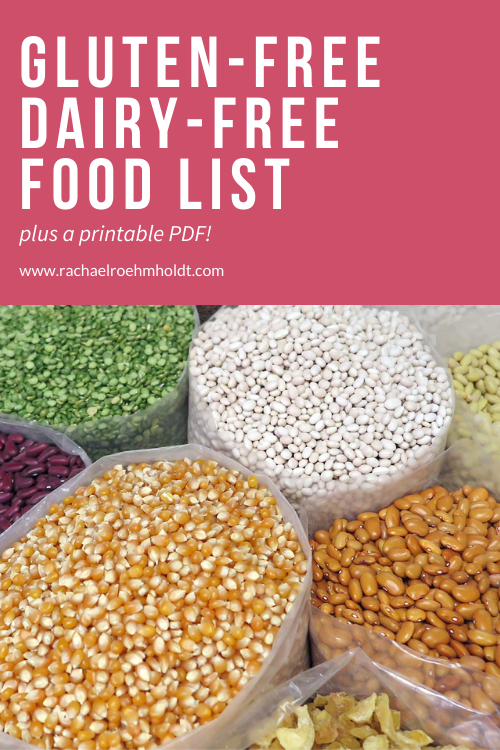
Beans
Beans are naturally gluten-free when prepared simply and as close to their natural form as possible. Both dry and canned beans are a good option, as long as no other ingredients have been added that contain gluten.
Beans can be used in soups, chilis, Mexican dishes, salads, or pureed into hummus and bean dips. I’ve even seen people add beans to dessert recipes!
- Black beans
- Chickpeas (aka garbanzo beans)
- Lentils
- Adzuki beans
- Cannellini beans (white beans)
- Fava beans
- Great Northern beans
- Kidney beans
- Mung beans
- Pinto beans
Meat, fish & eggs
Any meat, poultry, fish, and eggs are naturally gluten-free and when bought fresh or frozen will be a great option for your gluten and dairy-free diet.
The places you’ll want to watch out for are the processed meats or anything that has been pre-seasoned before you buy it.
It’s a good idea to look for gluten-free labels or review ingredients lists before buying. Enjoy any of these as protein sources in your gluten and dairy-free diet.
- Beef
- Chicken and chicken breasts
- Turkey
- Gluten-free deli meat, pepperoni, salami cuts
- Gluten-free chicken apple sausage
- Pork, bacon, ham (check that its gluten-free if packaged)
- Fresh fish
- Other fresh seafood (packaged items need to be reviewed for gluten)
- Eggs
Canned & packaged products
It’s a great idea to have a well-stocked pantry with some canned and packaged foods to help you get quick meals to the table on your gluten and dairy-free diet.
These are some of the staple ingredients I keep in my pantry to make soups, pasta dinners, sandwiches, and quick lunches.
- Gluten-free chicken stock or chicken broth
- Gluten-free beef stock
- Gluten-free vegetable broth or stock
- Diced tomatoes
- Tomato paste
- Tomato sauce
- Marinara or spaghetti sauce
- Gluten-free tamari soy sauce
- Barbecue sauce
- Olives
- Chunk-light tuna
- Canned chicken
- Canned beans
- Gluten-free pasta
- Gluten-free rice noodles
- Gluten-free sandwich bread
- Gluten-free crackers
- Gluten-free corn tortilla chips
- Fruit & nut bars or snack bars
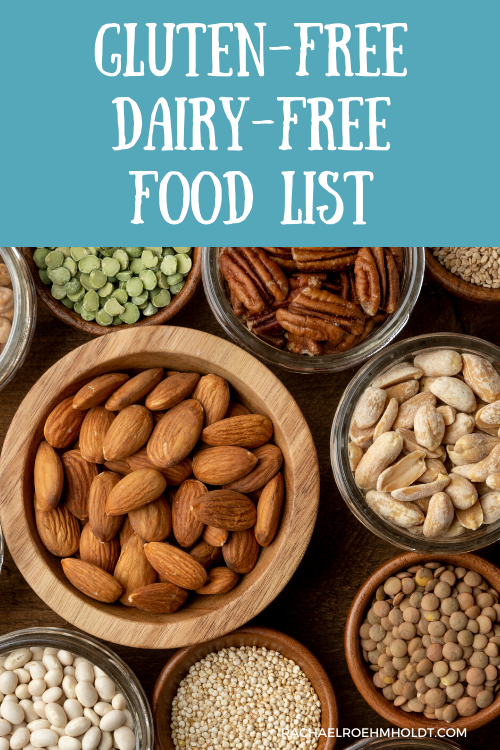
Condiments
There are so many condiments that have no gluten or dairy, which is amazing news for those of us who avoid these ingredients.
You can make a very simple dish taste completely different by swapping out herbs, condiments, and sauces.
Try this as an exercise: if you make a one-pan chicken dish with chicken, green beans, and potatoes – how many different flavors can you make it? I’d say an endless amount!
Here are just a few that come to mind and show the power of playing with condiments in your cooking: BBQ, honey mustard, dairy-free ranch seasoning, marinated with various salad dressings, Mediterranean-inspired with fresh herbs, capers, olives, and lemon juice.
- Fresh herbs (basil, parsley, cilantro, etc.)
- Hot sauce
- Ketchup
- Dijon mustard
- Whole grain mustard
- Yellow mustard
- Pickles
- Olives
- Capers
- Sauerkraut
- Gluten-free tamari soy sauce
- Barbecue sauce
- Salsa
- 100% whole fruit preserves or jam
- Maple syrup
- Nut butters (almond butter, cashew butter, etc.)
- Hummus
- Salad dressing
Read on: 17 gluten and dairy-free condiments
Herbs & spices
- Sea salt
- Kosher salt
- Pepper
- Garlic powder
- Onion powder
- Italian seasoning
- Basil
- Bay leaves
- Oregano
- Rosemary
- Thyme
- Cayenne pepper
- Cinnamon
- Cumin
- Nutmeg
- Red pepper flakes
- Curry powder
- Chinese five spice powder
- Chili powder
- Ground ginger
- Paprika
- Smoked paprika
- Mustard powder
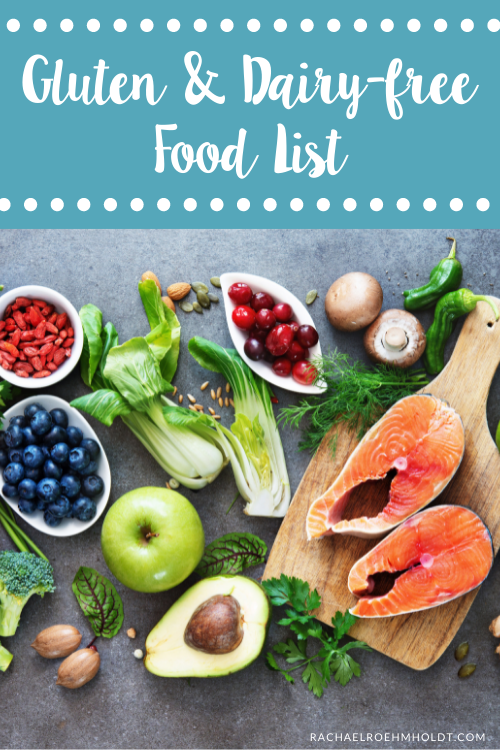
Dairy alternatives
Dairy alternatives have exploded in the past 8 years since I started on this diet. If you can blend something with water, you can turn it into milk – almonds, cashews, oats, rice, soy! The options are endless.
There are dairy-free butters, coffee creamers, cream cheese, sour cream, yogurt, salad dressings, and yes, even ice cream!! Try different varieties and different brands to find some that work for you and you like best.
- Full-fat canned coconut milk
- Earth Balance vegan butter
- Coconut milk (carton)
- Almond milk
- Cashew milk
- Rice milk
- Soy milk
- Hemp milk
- Oat milk (check for a gluten-free label)
- Dairy-free coffee creamer
- Coconut cream
- Vegan cheese (Daiya, Violife, Trader Joe’s)
- Dairy-free cream cheese
- Mayonnaise or vegenaise
- Dairy-free yogurt
- Dairy-free ice cream
- Dairy-free salad dressings
Oils & vinegars
Oils and vinegars help add some healthy fat and flavor to many of the meals I make. I keep these options on hand for homemade salad dressings, marinades, sauces, or to add some extra flavor to other dishes.
- Olive oil
- Coconut oil
- Sesame oil
- Toasted sesame oil
- Sunflower oil
- Grapeseed oil
- Balsamic vinegar
- Red wine vinegar
- White wine vinegar
If you’d like this list in a PDF form, be sure to enter your information below to get access.
Get the FREE Gluten-free Dairy-free Shopping List
Get access to the most comprehensive - and healthy! - gluten-free dairy-free shopping list around!
Plus get 5 sample gluten-free dairy-free recipes!
I hope if you’ve been looking for what foods you can enjoy on your gluten and dairy-free diet, that this list gives you a nice jumping off point.
It’s easier to make this transition when you focus on what you CAN eat rather than what you can’t.
Enjoy building meals around these ingredients and get creative with how you mix and match them.
You might be surprised how delicious being gluten and dairy-free really is!
